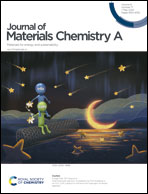Revealing the correlation between structural evolution and Li+ diffusion kinetics of nickel-rich cathode materials in Li-ion batteries†
Abstract
Nickel-rich cathode materials such as LiNi0.8Co0.1Mn0.1O2 (NCM811) are attracting widespread attention due to their high specific capacity and low cost. However, the low initial coulombic efficiency (CE) and poor rate performance of the materials have hindered the maximum utilization of their capacity. Here, we systematically investigated the causes of the low CE and correlation between structural evolution and Li+ diffusion kinetics during the first and following charge/discharge cycles. Combining GITT, in situ EIS and in situ XRD, we reveal that the diffusion of lithium ions is mainly affected by structural evolution or phase changes during charge–discharge cycling. The lithium diffusion kinetics of the H1 phase at high lithium content is rather slow, and this together with the decrease of lithium vacancies contributes to the sharp decrease of the lithium diffusion coefficient at the end of discharge. The slow kinetics of the H1 phase is even more conspicuous at low temperature as evidenced by in situ XRD and GITT experiments at low temperature. In addition, a new charge/discharge mode is proposed and demonstrated for increasing the deliverable discharge capacity and CE at the first cycle for NCM811 cathode materials.



 Please wait while we load your content...
Please wait while we load your content...